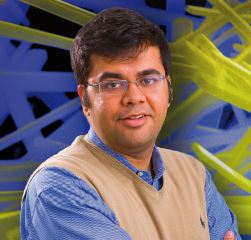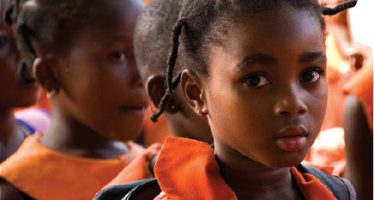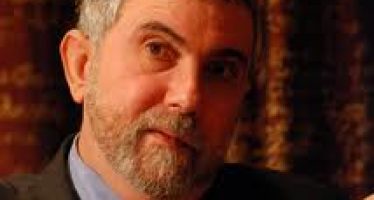USAID: Science and Engineering Diaspora Networks – Communities Mobilizing to Solve Global Development Challenges

Scientist: Sarbajit Banerjee
Source: Douglas Levere, UB Reporter, University of Buffalo
In a research lab at the University of Buffalo (UB), New York, scientist Sarbajit Banerjee and his colleagues have honed in on a confounding problem – how to efficiently cool homes in hot climates. These researchers are testing the potential of coatings roofs and windows with vanadium oxide, a synthetic compound that reflects heat once the temperature reaches a critical point. Banerjee and his team believe they have found a so-called “moonshot” solution – a radical solution using breakthrough technology to address a global problem – which in this case can be applied for sustainable low-cost housing in developing countries. Banerjee stresses the enormous environmental implications: “This technology is of particular interest in developing countries, where the use of air conditioning is rising. Not only is this straining nascent power grids, but it’s also dumping hundreds of millions of tons of carbon dioxide into the atmosphere. And this isn’t just a problem for houses, but also for cars, where by some accounts vehicle air-conditioning units in the United States alone use 7 billion gallons of gasoline each year.”
Banerjee is both a diasporan and a scientist – he emigrated from India and is currently an Associate Professor of Chemistry at UB and co-director of UB’s New York State Center of Excellence in Materials Informatics. Individuals like Banerjee make up a community of diasporans in the science and engineering fields. While affinity to their country of origin often creates a lasting emotional bond, their pedagogy instills a degree of objectivity and scientific rigor to solving problem sets.
At USAID and the State Department, we recognize that harnessing both this affinity and the expertise of science and engineering diaspora networks can help tackle some of the greatest problems developing countries face while bridging cultural and economic gaps between the United States and the rest of the world.
“The U.S. government is striving to offer more opportunities to build strong collaborative partnerships in science and technology around the world.”
In May 2013, Banerjee was invited to give a lecture titled “Windows and roofs that adapt to the outside environment: Toward greener housing in the developing world” at the Global Diaspora Forum. His eight-minute lecture was one of several TED-style talks featured in a Solve for <x> event at the forum in partnership with Google to amplify science-based “moonshot” thinking. “Moonshots” are described by Google as radical solutions that use breakthrough ideas and cutting-edge technology to address global problems that affect millions or billions of people.
Banerjee’s lecture was part of the third-annual forum which is co-hosted by the U.S. Department of State’s Office of Global Partnerships and the United States Agency for International Development (USAID), to celebrate the role of diaspora communities in development and diplomacy. In 2012, an initiative called Networks of Diaspora for Engineers and Scientists, or NODES was launched as a partnership between the Department of State, the American Association for the Advancement of Science, and the National Academy of Sciences. NODES connects diaspora scientists across boundaries and in the past year has convened scientists and diaspora groups from over 30 countries.
NODES and similar efforts by other U.S. government agencies recognize that science diplomacy is not just a smart tool that brings experts together for collaboration under a “non-political” umbrella but an imperative in order to address some of the most pressing global challenges of our time that will depend on innovative thinking and technological breakthroughs for scalable solutions. An often-neglected byproduct of these collaborations is that science and engineering diasporans also play the role of “cultural translators” to communicate inventions in the U.S. that may have even greater utility in other countries.
There is great potential for U.S. diaspora scientists and engineers to play a pivotal role in knowledge transfer, entrepreneurship, and commercialization of ideas in their countries of origin or heritage. Take for example the research work of Imran Khan, an Assistant Professor in the Department of Pathology and Laboratory Medicine at the Center for Comparative Medicine at the UC Davis Medical Center. Khan, together with his colleague Paul Luciw in the same department led the development of a low-cost, quick screening technique to identify whether children have reached a deadly stage of tuberculosis.
At least 600 million people in Pakistan, India and Bangladesh are infected with the tuberculosis bacterium Mycobacterium tuberculosis and about 400,000 die from the disease in South Asia every year. This new screening which can benefit millions of people worldwide resulted from research collaborations with their Pakistani colleagues at the Arid Agriculture University and Punjab University under a joint Pakistan-U.S. Science and Technology Program funded by USAID and the State Department.
The U.S. government is striving to offer more opportunities to build strong collaborative partnerships in science and technology around the world. In 2011, USAID launched the Partnerships for Enhanced Engagement in Research (PEER) Science program, a partnership between the USAID and the NSF that provides funding support to researchers from 87 eligible countries working collaboratively with NSF-funded scientists based in the U.S. These collaborations can lead to dramatic breakthroughs in development-related topics such as natural resource management in the Philippines, water issues in the Middle East and North Africa, biodiversity in the Lower Mekong Region and Brazil, and climate change adaptation in the Maldives.
While some may chide the “brain drain” of highly-skilled individuals who leave their countries of origin for better opportunities, the fact is that there are many science and engineering diaspora networks that maintain ties and help build scientific capacity in their home countries.
Take for example the efforts of the Caribbean diaspora to establish a Caribbean Diaspora for Science, Technology and Innovation, a collection of Caribbean professionals who have an interest in building scientific capacity to benefit the development of the Caribbean Region. Or of the Irish scientific diaspora community to create the Wild Geese Network of Irish Scientists to connect Irish scientific, technological and engineering diaspora, disseminate information about funding opportunities and forge networks to create bilateral partnerships.
The global challenges in access to energy, sustainability, agriculture, health, education and infrastructure that underlie poverty require not just resources but talent. The community of science and engineering diasporas in the United States is a valuable asset and a key stakeholder group in our diplomacy and development policies. Their expertise, combined with an inherent cultural awareness and sensitivity that cannot be acquired, can help the U.S. government dream bigger and find the next “moonshot” solutions as we reshape the way we think about science for development.
About the Author
Romi Bhatia is a Senior Advisor for Diaspora Partnerships in the Global Partnerships Division at the US Agency for International Development. He is part of the core team that is helping to drive the Agency’s engagement with diaspora communities in the U.S. in order to achieve development objectives of the Agency.
Sources
• http://www.buffalo.edu/news/releases/2013/05/053.html
• http://pakistanlink.org/Community/2013/Sep13/06/05.HTM
Questions and inquiries about how to partner with USAID can be directed to: [email protected]
You may have an interest in also reading…
World Bank Group: “Customer is King” – Toward More Effective Development?
“Customer is King” is an old business saying that accentuates the importance of customers in every business. The private sector
Paul Krugman: A Plea for a Return to Basics in Finance
Author of no less than twenty books, over 200 scholarly essays in peer-reviewed academic journals and more than 750 articles
Ross Jackson: Nero Politics Meet Limits to Growth
Nero – the last emperor of the Roman Empire – is best remembered as the man who fiddled while Rome



















































































